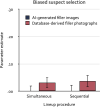On the advantages of using AI-generated images of filler faces for creating fair lineups
- PMID: 38811714
- PMCID: PMC11137153
- DOI: 10.1038/s41598-024-63004-z
On the advantages of using AI-generated images of filler faces for creating fair lineups
Abstract
Recent advances in artificial intelligence (AI) enable the generation of realistic facial images that can be used in police lineups. The use of AI image generation offers pragmatic advantages in that it allows practitioners to generate filler images directly from the description of the culprit using text-to-image generation, avoids the violation of identity rights of natural persons who are not suspects and eliminates the constraints of being bound to a database with a limited set of photographs. However, the risk exists that using AI-generated filler images provokes more biased selection of the suspect if eyewitnesses are able to distinguish AI-generated filler images from the photograph of the suspect's face. Using a model-based analysis, we compared biased suspect selection directly between lineups with AI-generated filler images and lineups with database-derived filler photographs. The results show that the lineups with AI-generated filler images were perfectly fair and, in fact, led to less biased suspect selection than the lineups with database-derived filler photographs used in previous experiments. These results are encouraging with regard to the potential of AI image generation for constructing fair lineups which should inspire more systematic research on the feasibility of adopting AI technology in forensic settings.
Keywords: AI image generation; Generative artificial intelligence; Lineup fairness; Sequential lineups; Simultaneous lineups.
© 2024. The Author(s).
Conflict of interest statement
The authors declare no competing interests.
Figures


Similar articles
-
Can AI-generated faces serve as fillers in eyewitness lineups?Memory. 2025 Apr;33(4):416-429. doi: 10.1080/09658211.2025.2467134. Epub 2025 Feb 20. Memory. 2025. PMID: 39977276
-
Creating fair lineups for suspects with distinctive features.Psychol Sci. 2009 Dec;20(12):1448-53. doi: 10.1111/j.1467-9280.2009.02463.x. Epub 2009 Oct 30. Psychol Sci. 2009. PMID: 19883492
-
Why are lineups better than showups? A test of the filler siphoning and enhanced discriminability accounts.J Exp Psychol Appl. 2020 Mar;26(1):124-143. doi: 10.1037/xap0000218. Epub 2019 Mar 18. J Exp Psychol Appl. 2020. PMID: 30883151
-
Suspect filler similarity in eyewitness lineups: a literature review and a novel methodology.Law Hum Behav. 2015 Feb;39(1):62-74. doi: 10.1037/lhb0000095. Epub 2014 Jun 23. Law Hum Behav. 2015. PMID: 24955851 Review.
-
Thinking outside the red box: Does the simultaneous Showup distinguish between filler siphoning and diagnostic feature detection accounts of lineup/Showup differences?Cognition. 2024 Dec;253:105930. doi: 10.1016/j.cognition.2024.105930. Epub 2024 Aug 31. Cognition. 2024. PMID: 39217783 Review.
Cited by
-
The effect of lineup size on discriminability is dependent on filler similarity and independent of encoding strength.Mem Cognit. 2025 May;53(4):1272-1286. doi: 10.3758/s13421-024-01649-x. Epub 2024 Nov 7. Mem Cognit. 2025. PMID: 39509017
-
Lineup position affects guessing-based selection but not culprit-presence detection in simultaneous and sequential lineups.Sci Rep. 2024 Nov 12;14(1):27642. doi: 10.1038/s41598-024-78936-9. Sci Rep. 2024. PMID: 39532964 Free PMC article.
-
Delays reduce culprit-presence detection but do not affect guessing-based selection in response to lineups.Sci Rep. 2025 Aug 4;15(1):28382. doi: 10.1038/s41598-025-13937-w. Sci Rep. 2025. PMID: 40759723 Free PMC article.
References
-
- Khoo B, Phan RC-W, Lim C-H. Deepfake attribution: On the source identification of artificially generated images. WIREs Data Min. Knowl. Discov. 2022;12:e1438. doi: 10.1002/widm.1438. - DOI
-
- Morgan NS. Pen, print, and pentium. Technol. Forecast. Soc. Change. 1997;54:11–16. doi: 10.1016/S0040-1625(97)87500-2. - DOI
-
- Rajaram S, Marsh EJ. Cognition in the Internet age: What are the important questions? J. Appl. Res. Mem. Cogn. 2019;8:46–49. doi: 10.1016/j.jarmac.2019.01.004. - DOI
MeSH terms
Grants and funding
LinkOut - more resources
Full Text Sources

